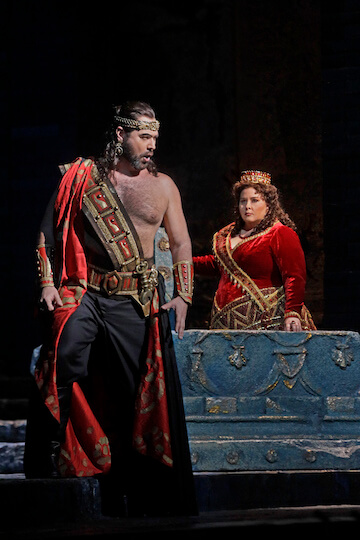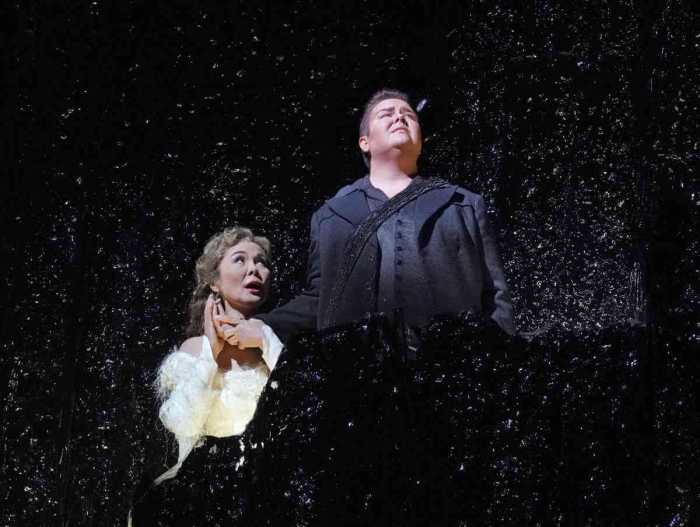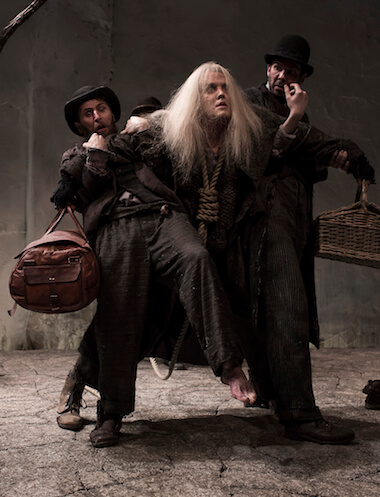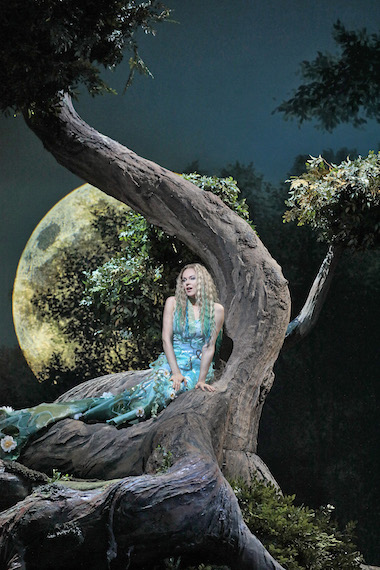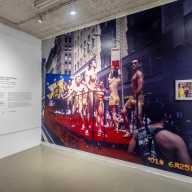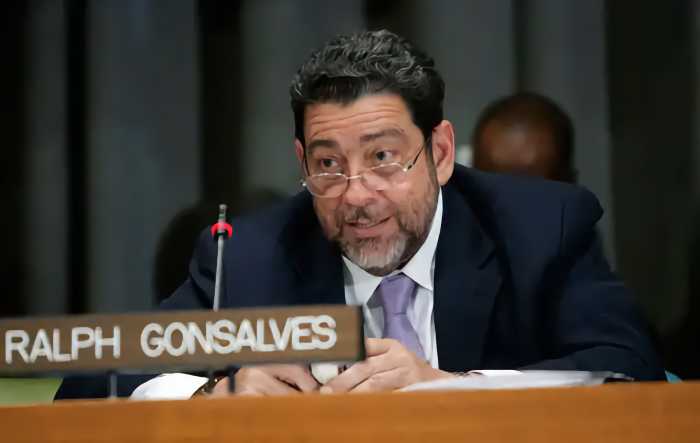Ildar Abdrazakov and Angela Meade in the Metropolitan Opera’s production of Rossini’s “Semiramide.” | KEN HOWARD/ METROPOLITAN OPERA
BY ELI JACOBSON | “Semiramide” was Gioachino Rossini’s final opera for Italy, the last soprano role he composed for his wife Isabella Colbran, and the ultimate Italian opera seria in the classical tradition. It premiered in Venice in February 1823 and immediately afterwards Rossini moved to Paris. In France, Rossini eventually traded Italian opera for French grand opera and his first wife Colbran for the courtesan Olympe Pélissier. Finally, Rossini left operatic composition itself behind.
According to musicologist Rodolfo Celletti, “Semiramide” represents “the last opera of the great Baroque tradition: the most beautiful, the most imaginative, possibly the most complete; but also, irremediably, the last.” Rossini harkens back to Baroque subject matter, musical structure, and forms and demands virtuoso coloratura technique from soprano, contralto, tenor, and bass.
In 1990, the Met unveiled its first production in nearly a century for Marilyn Horne, utilizing the newly compiled uncut critical edition by Philip Gossett. After an absence of more than 20 seasons, the Met brought back John Copley’s “Semiramide” production spotlighting two emerging American bel canto stylists: Angela Meade and Elizabeth DeShong in the bravura roles of Semiramide and Arsace.
Met revives John Copley’s production of Rossini’s “Semiramide”
Seen at the fifth performance on March 6, the cast was settled in, tenor Javier Camarena and conductor Maurizio Benini were recovered from the illnesses that sidelined them from earlier shows, and everything ran smoothly. The two ladies acquitted themselves well without that last ounce of star charisma and authority that separates the talented vocalist from the superstar. “Semiramide” requires superstars, and divas like Pasta, Patti, Melba, Sutherland, and Horne are what kept this opera from languishing in obscurity.
Meade as the guilty Babylonian queen threw in elaborate embellishments spotlighting her upper range, including a brief tiny E natural in “Bel Raggio.” As originally composed for the declining Colbran, the part is not high so the embellishments raise the tessitura. I found Meade’s variations lacked Rossini style, evoking the late 19th century decorative songbird tradition, and some of her fast runs were approximated. However, she impressed in the two extended duets with DeShong and scored expressively with Semiramide’s final prayer “Al mio pregar t’arrendi” at the end of Act II. Dramatically, Meade knows how to model a golden crown, kick her train, and throw a sinister glare at an enemy.
DeShong possesses a creamy, even mezzo-soprano with accurate coloratura and seamless phrasing. Her soft-grained, medium-sized voice, however, lacks the thrust and impact of a Horne or an Ewa Podles. DeShong cut a rather diminutive, uncharismatic stage figure as Arsace, and Roy Rallo’s unspecific revival direction didn’t help her create a heroic protagonist. I was pleased with DeShong’s technical security, sympathetic timbre, and stylish ornamentation but her voice and personality don’t jump over the footlights.
Both Camarena and Ildar Abdrazakov began their careers as Rossini specialists but in the last decade have branched out into bigger 19th century grand opera roles with voices that have gained in weight and breadth. Camarena in the dramatically superfluous role of Prince Idreno flaunted undeniable vocal star quality — his gorgeous tenor tone just soared out into the auditorium. He tossed in stentorian high C’s at the drop of a hat (one got away from him — probably a result of his recent indisposition). However, both Camarena and Abdrazakov struggled with the sixteenth notes and syncopated passage work.
Abdrazakov as the villainous Assur, after some woolly scale work in the Act I ensemble, scored in Assur’s Act II mad scene. He also has great personal charisma and looked formidable with his hairy barrel chest stripped to the waist (the original Assur in this production was Samuel Ramey who stole the show — some thought the opera should have been retitled “Sammy Ramey Day”).
Ryan Speedo Green as the high priest Oroe emoted more than low-voiced high priests usually do and poured lots of velvety chocolate bass-baritone goodness over his oracular statements.
In the pit, Benini led an efficient, routinier reading of a cut edition that trimmed 45 minutes from Rossini’s jewel box of a score. The tempos ambled along steadily, gliding over the contrasting accents and subtle details that Rossini liberally worked into his orchestration.
The Copley production is handsome and smoothly utilizes the old Baroque three section stage with intimate scenes played downstage “in one,” while grander scenes are prepared upstage and revealed by a raised drop. The staging, however, also revives the 19th century tradition of the tableau with serried chorus members moving and reacting in unison upstage and the soloists lined up in a row downstage. This does little to animate the static dramaturgy of Rossini’s adaptation of a Voltaire tragedy.
John Conklin’s distressed Babylonian palace sets were painstakingly restored and strikingly relit by John Froelich. Michael Stennett’s glittery costumes, with towering headdresses for men and women, evoked “Beach Blanket Babylon” — and that is a good thing! “Semiramide” is an operatic masterpiece in a style that was soon to go out of fashion after 1823. In this rare revival, Rossini’s genius was honored not with flashing brilliance but a steady warm glow.
The Metropolitan Opera fielded three Normas this season — Sondra Radvanovsky and Marina Rebeka in October replaced Anna Netrebko, who cancelled. Angela Meade took over the new McVicar production for a short December run. Meade first unveiled her Norma at the Met back in 2014, spelling Radvanovsky for two performances with Jamie Barton as her Adalgisa. Meade and Barton repeated their Norma double act at the Met as a much more finished artists.
Meade’s take on Norma was the inverse of Radvanovsky’s: Radvanovsky’s commitment and dramatic force compensated for a voice that has some edge and wear and lacks lyrical repose. Meade (heard December 5) was vocally impeccable with clean runs and trills, lush sweetness in cantabile passages, and high E flats interpolated at every opportunity (including a high E at the conclusion of the stretta of the Act II duet with Pollione). She was, however, very much an acting singer rather than a singing actress. Meade has worked out very vocal detail and gauged the effect of each phrase, developing great musical authority in the role. Her stage temperament leans to the placid and demure, and she is less naturally charismatic onstage than Radvanovsky. She is also more limited in movement.
There is also the question of vocal attack — Norma has many angry outbursts and Radvanovsky was not afraid to jump in and make the conductor follow her. Meade follows the conductor’s lead making her tirades sound less spontaneous.
Over the decades, there have been continuing complaints that contemporary young singers do not develop their vocal technique to the degree that past “Golden Age” greats did. Meade emulates her idols Caballé and Sutherland as a technical virtuosa, but as an operatic artist she needs a little Callas-like abandon. It must be said that Meade has grown exponentially in the role since 2014 and is still a developing artist.
Barton, too, has huge vocal resources used with impudent command. The tradition of a heavy mezzo-soprano Adalgisa is a modern invention — Bellini wrote it for a youthful, brighter sounding full lyric soprano (Giulia Grisi). There are some quick coloratura sections in the Act I duets where Barton was struggling to keep her voice light and high. However, she has a wide range of vocal color from bright girlish soprano tone suggesting innocence to smoldering contralto chest tones. This wide vocal palette served to paint a deeply conflicted character unable to reconcile her duties as a priestess with her overpowering attraction to Pollione.
Barton was costumed and wigged very differently from Joyce DiDonato — whereas DiDonato had a short blonde pixie cut and fashionably distressed gowns, Barton was given a long flowing dark wig and much less revealing costumes. This made it difficult at times (given their similar full-figured silhouettes and the shadowy lighting) to determine which diva was which until they started to sing. In the duets, Meade and Barton expertly blended their contrasting timbres, keeping in strict musical sync.
Joseph Calleja was in superior vocal form than he was in the fall run with a firm high C in his opening aria. In the lyrically expansive music of the final scene, Calleja reached peak form — his plangent tenor is too soft-grained for Pollione’s martial entrance aria. Matthew Rose energetically blustered as a “can belto” warrior priest Oroveso, and the chorus was in fine voice. Joseph Colaneri led the orchestra with a raw vigor more reminiscent of early Verdi than classical bel canto. The cast benefited from his rhythmic energy.
Rebeka took over the two last performances in October and also proved a vocally fluent, musically authoritative Norma. The Latvian soprano has previously specialized in lyric and lyric coloratura roles at the Metropolitan Opera. The clear silken quality of her soprano is compromised by a rim of Slavic steel. That metallic rim on the tone can be displeasing in lyric roles but is quite exciting in dramatic repertoire like Norma where it sounded appropriate and added a dramatic thrust to her phrasing.
Radvanovsky also has an edgy voice but Rebeka’s is a more consistent instrument with smoother emission. Her big, bright healthy voice smoothly reached all the notes without strain and filled out Bellini’s long vocal line with unbroken legato. She has a great high C but the trill was barely there and the high D at the end of the trio was a scream. The bright, even voice with easy reach and attack up to high C reminded me in some ways of early Sutherland as Norma but lacks La Stupenda’s brilliant timbre and agility. Rebeka isn't a fiery actress and plays Norma as a youthful betrayed wife and sorrowful mother while Radvanovsky and Meade had more gravitas as a high priestess and leader of the Druids.
The Metropolitan Opera, after losing a superstar Norma (Anna Netrebko) late in the game, should be commended for being able to present three vocally imposing and musically interesting interpreters of the supreme bel canto soprano role in one season on short notice.

